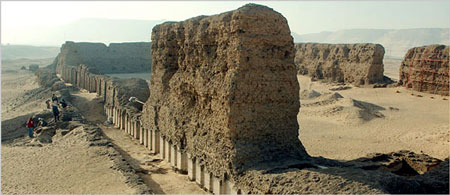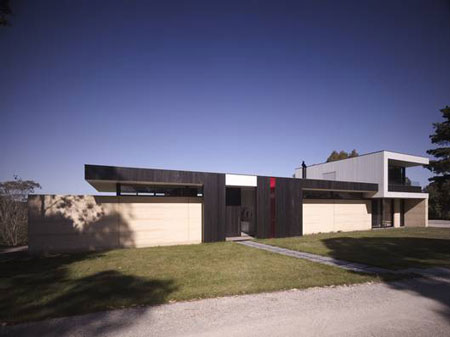Want to talk about earth architecture? Join the discussion at Archinect.
Down and Dirty
The article Down and Dirty from the New York Times, discusses the growing populatiry of earthen floors. (subscription required)
Early one Saturday morning in January, Kevin Rowell dumped a bucket of dark mud on the floor of his big south-facing bedroom. It landed with a plop, spreading out and merging with a blanket of wet earth that already extended across much of the room. On his knees, Mr. Rowell took a trowel to the pile, nudging it this way and that until the mud was roughly level and about an inch and a half deep.
Seminario y Workshop: Arquitectura y Construcción en Tierra Cruda
ARQUITECTURA Y CONSTRUCCIÓN EN TIERRA CRUDA
22 al 27 de Enero. Comunidad Ecológica de Peñalolén, Santiago, Chile.
ORGANIZA: Oficina de Arquitectura y Construcción, Marcelo Cortés y Patricio Arias.
PATROCINA: Comité de Tecnología del Colegio de Arquitectos de Chile.
PRESENTACIÓN
El Encuentro Nacional de Arquitectura y Construcción en Tierra Cruda, nace con la idea de reunir en un mismo espacio, tanto a profesionales de la construcción con tierra cruda, como a personas provenientes de distintas disciplinas, interesadas en aprender y compartir experiencias, sobre las técnicas y posibilidades que entrega este material, en el campo de la construcción.
El objetivo del encuentro, es profundizar sobre las nuevas tecnologías constructivas empleadas actualmente en la construcción en tierra – las cuales se gestan a partir de reinterpretaciones de las técnicas tradicionales-, a la vez que abrir un diálogo sobre las ventajas que posibilita este material, como sobre las problemáticas que enfrentan en nuestro país, las construcciones patrimoniales construidas en tierra cruda.
[ descarga afiche ] Continue reading “Seminario y Workshop: Arquitectura y Construcción en Tierra Cruda”
Rammed Earth & Modular Contained Earth
Alternative Construction: Rammed Earth & Modular Contained Earth is a 3-hour interactive online course examines the systems and materials associated with alternative construction, including scenarios on the uses of rammed earth and modular contained earth. It discusses their histories, environmental impacts, and construction methods. This is part of a series of courses concerning Alternative Construction: Contemporary Natural Building Methods.
Shunet el-Zebib

photo: Institute of Fine Arts, N.Y.U./American Research Center in Egypt
Before the great pyramids, ancient Egyptian kings left less grandiose monuments to themselves: fortresslike sanctuaries enclosed by mud-brick walls. Inside these mortuary complexes, people presumably gathered to worship and perpetuate the memory of their departed ruler. The crumbling, almost vanished remains of such structures, archaeologists say, attest to the political hierarchy and religion of the newly unified Egyptian state, beginning more than 5,000 years ago.
Abari
![]()
Abari is a not-for-profit organization that examines, encourages, and celebrates the vernacular architectural tradition of Nepal. Much of that tradition includes the use of mud brick as seen traditionally in Eastern Kathmandu and in their recent Gobi Adobe project.
Saddam Hussein: 1937-2006

Saddam Hussein was born in a mud brick house to a family of sheep-herders in Tikrit, Iraq on April 28, 1937. He grew up in the town of Al Dawr, a mud brick town on the banks of the Tigris River.
Iraq is home to some of the most enduring wonders built in mud from the ancient world include the Ziggurat at Ur and the Ctesiphon Arch, the largest single-span vault of un-reinforced mud brick in the world. Adobe dwellings in Iraq date back as far as 8000 b.c. and the earliest known form molded adobe blocks are also in Iraq (5600 b.c).
The ruins of the ancient city of Babylon are also found in Iraq. Herodotus, the ancient Greek scholar, was so wowed that he wrote Babylon “surpasses in splendor any city in the known world.” Most of the splendor was made from mud and virtually all buildings in Babylon are constructed in mud brick. It was been an old Mesopotamian custom to impress the bricks, mainly those destined for public buildings, with the king’s seal.
Saddam Hussein wanted to be seen as the modern version of Nebuchadrezzar the Great, who ruled Bablyon in the 6th Century B.C.E. and is famous for bringing the city back to power and prosperity after a century of foreign rule by the Assyrian Empire. To make the connection clear, Saddam had a historically incorrect version of a 6th Century temple built atop the ruins of Nebuchadnezzar’s old temple. Walls more than 12 meters high and stamped with Saddam’s name replaced the stumpy mounds of biblical-age mud. Just as the ancient temple’s bricks bore the old king’s name, the new bricks said, “This was built by Saddam Hussein, son of Nebuchadnezzar, to glorify Iraq.” Following this, Saddam built a copy of a Sumerian ziggurat built on the mud brick ruins of the city. Modern archeologists frowned heavily upon him for building on top of old ruins.
Saddam Hussien was executed today, December 30, 2006 for crimes against humanity.
Trilogy
Red Hill Residence

The Red Hill Residence designed by CHRISTOPHERCHRIS PTY LTD ARCHITECTURE was constructed in Mornington Peninsula, Australia. More images of the project can be found at Arkinetia where they write, the house is “constructed primarily from locally sourced rammed earth and ship lapped cedar panelling, the house is sited across the ridge of the property. The elemental form of the building is enhanced by the contrasting and intersecting selection of material, textures and colours, threaded together by the linear rammed earth wall.”
5o Seminario Arquitectura de Terra em Portugal
The Fifth Annual Conference of Earthen Architecture in Portugal will take place October 10-13, 2007 at the University de Aveiro in Portugal. For more information, download the conference brief (Portugues Language).
